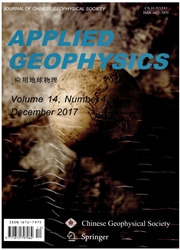

 中文摘要:
中文摘要:
核磁共振找水是目前唯一能够直接探测地下水的地球物理方法,本文在weichman等人改进的核磁共振理论的基础上,应用经典的Chave算法对含有贝寨尔函数的积分核进行积分,求得了地下磁场和垂育激发场的空间分布。通过计算地下垂直激发场的椭圆极化率,验证了垂直激发场的椭圆极化效应,发现当地下电导率较大时椭圆极化效应将导致垂直激发场严重畸变;地下垂直激发场的正旋和逆旋分量显示了椭圆极化效应对核磁共振找水激发和接收上的不同影响,发射线圈和接收线圈间的延迟相位揭示了相位延迟效应的存在性及其相关性质。将以上理论应用到共圈模式下的核磁共振找水响应函数中,得到了地下氢核的扳倒角、地面核磁共振找水核函数和单一含水层模型的响应曲线,发现椭圆极化效应和相位延迟效应将导致核磁共振找水响应发生明显改变,因此对核磁共振找水理论和实际研究考虑椭圆极化效应是十分必要的。
 英文摘要:
英文摘要:
Currently, surface nuclear magnetic resonance (SNMR) method is the only geophysical method that detects groundwater directly. In this paper, we investigate the effect of elliptical polarization in the perpendicular excitation magnetic field. The effect of elliptical polarization is clearly visible in our ellipticity calculation and it can cause strong distortion to the excitation field in the presence of high subsurface conductivities. By examining the co-rotating and counter-rotating components of the field, we show that elliptical polarization affects transmitting and receiving processes differently and that a clear phase lag exists between transmitter loop and receiver loop. Finally, we derive the response function of coincident loops and calculate proton tip angles, the kernel function and SNMR response curves of a 1D aquifer model. Based on the simulations, we conclude that the elliptical polarization and phase lag can significantly affect SNMR response and it is essential to include elliptical polarization in SNMR modeling and data interpretation.
 同期刊论文项目
同期刊论文项目
 同项目期刊论文
同项目期刊论文
 期刊信息
期刊信息
